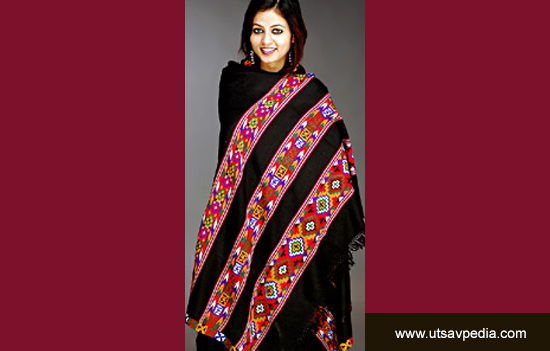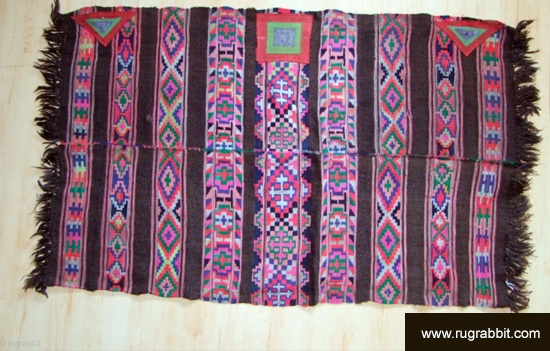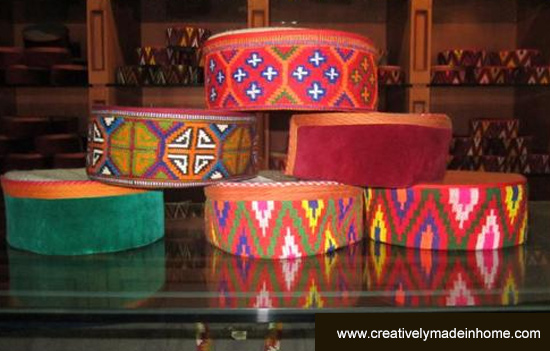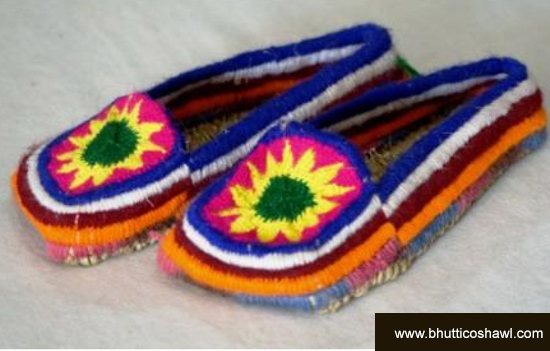- Know
about the handlooms garments of Himachal. Since weather is cold, focus is on woollen
garments.
Fabrics
are an essential part of the cloth and varied. To choose a correct type of
fabric for clothing is the most difficult job for the retailer, a challenge. The
customer may demand any type of fabric, so the retailer should keep all types
of fabric with him.
In a country like India, options are many because every state has a different fabric. This piece is about handlooms of a beautiful state i.e. “Himachal Pradesh”. The word Himachal means ‘abode of snow’. State is mostly hilly areas. Shimla is its capital. It has lots of natural beauty and a popular tourist destination.
A
variety of fabrics are famous in the state. For e.g. Chamba rumal, thapada etc.
The good part is these are available in Himachal Pradesh. The varieties available
in Himachal Pradesh are:
Chamba Rumal Embroidery

Reference
and Credits
The
Chamba Rumal is also known as Chamba handkerchief is an embroidered handicraft
of Punjab.
Chamba
Rumal is that the subjects were drawn in outline by the women/girls on the
court. Chamba embroidery was basically based on environment, nature, local tradition
and happenings of everyday life, cheerfulness, and elements of nature. Geometrical
designs are popular in Chamba Rumal.
The
embroidery of this was done in soft shades in small double darning stitches
which appear the same on both sides. Outlines and details of this were worked
in double running stitches and sometimes even small patterns on costumes and
other details of this were shown in coloured darning stitch.
The
embroiderer who made this used to create Chaupar.
It is a game of dice which is played on two long bands of cloth joined together
to form a cross in cloth, on the Rumal with four sets of players seated on the
four sides. Chamba Rumal Embroidery also showed elements of nature like fruits
banana, lotus flower, peacock, parrots, shrubs, monkeys, deer, fish, clouds,
cranes etc.
The
figures and floral patterns of this are drawn on Chamba rumals. These are
filled with pat, which is a type of untwisted silken floss. Chamba Rumals are
usually made of square or rectangular fabric of cloth of varying sizes and
designs. Chamba embroidery is done on beautiful shawls and quilts. Hence
experts suggest to dry clean and keep it away from harsh sunlight which might
damage its silken threads.
Thapada Shawl

Thapada
is the most popular embroidery and best garment available in Himachal Pradesh.
Thapada usually represents the shawl with the best features of wider patterns
and decoration. It is woven by hand or machines which are being found
exclusively in Himachal.
Thapada
has a special trend of embroidery which makes it look beautiful. It also varies
between wide ethnic ranges. This gives it a traditional look.
Thappada
is, usually draped over garments, used for special occasion gatherings. It can
be worn with numerous combinations thus making it very popular. Thapada makers
are wonderful creators and designers. Being handmade, true appreciators choose
them over modern gadgets or machine-made sophisticated garments.
The
Thapada is a Himachal specialty i.e. appreciated across India. The texture of a
Thapada is smooth and pleasant. It is a warmth retaining garment.
Reference
Kinnauri shawls

Reference
and Credits
Kinnauri
Shawl is made in Kinnaur district. These shawls are well known for their
geometric designs and pattern. It takes about 45 days to weave one shawl.
Kinnauri
Shawls patterns are unique. They are woven in stripes, and have intricate
patterns and adorned with rich and bright colors running through their borders.
These
shawls have elaborate geometric patterns at the both of their ends. It takes
almost six to eight months in a year to complete one such work of art i.e.
kinnauri.
To see good
pictures of Kinnauri and Kullu shawls
Lingchay – hand woven shawl

A
Lingchay is a hand-woven shawl locally used as a shoulder wrap. Found in
profound variety and colour, it is woven on manual looms by the rural women of
mountainous Spiti in Himachal Pradesh.
Kullu Caps

Reference
and Credits
Caps
of this variety are associated with Himachal Pradesh. Colorful caps fascinate
everyone at first instance.
The traditional yet stylish headgear derives its name from the place of its origin. Locally, it is called as Kullu topi and is an important part of a local man’s attire. From the cap design one can know which part of the state the person belongs to.
The
Kullu cap is round in shape and flat on the top. A band of colorful border
brightens the front with a beautiful pattern. This is separately woven on small
looms and the back portion, which covers the head is made of local woollen yarn
and sometimes made of cotton or any other light material. The cap also keeps
the head warm in the cool climes of Himachal.
Nowdays
plain velvet caps in maroon and green colours are also available in the market.
Once use of bright colours in the cap was the significant feature of the caps
but nowadays, vegetable colours are being used.
These
caps are categorized as small, medium and large. The price of a Kullu cap
depends on the cloth used and the pattern on the border.
To read about Kullu Caps
Thobi
Thobi
is a type of floor covering, which is spun from goat hair. It is woven in two
portions of half width and later joined from the centre with very complicated
stitches. It is rough in texture, but provides warmth.
Thobi
is usually plain or available in checks or bands of black and grey. The size of
the thobi varies from 2.15 x 0.9 m to 3.5 x 1.50 m and weighs approximately
600-800 gm. Thobis are generally woven for fulfilling personal needs.
Numdha
Numdha
is the local name for a mattress, which is made by felting the wool rather than
weaving it. It is prepared by mixing low quality wool with a small quantity of
cotton.
Numdhas
are usually plain or decorated with embroidered colourful designs. These
mattresses come in different sizes as 1.82 x 0.91 meters or 3.65 x 3.04 meters.
The price of numdhas depends on its size, quality of wool and the pattern.
Gudma
Gudma
is a soft but heavy blanket, which is woven especially in Kullu valley as this
place has a special kind of clay that is used to clean and finish a Gudma.
It
is made of Byang wool having long fibres. Gudmas are woven in natural wool
colours and finished with red or black trimmings. Size of gudmas is similar to
those of numdhas. Cost of gudmas also varies according to size.
Pattu
A
woollen fabric draped by women like a sarong, used for everyday wear are plain
or chequered with simple borders.
The
ones worn during festive occasion are ornately patterned with designs motifs
along with the weft as well as warp. Many times pattus may have a red border called
Khusti running along the vertical
edge.
 Pattu.
Pattu.
Since
the last few years there is a trend of stitching a separate khusti or a
patterned border at selvedge of the pattu with the intent of reducing the labor
involved and making it cheaper, without reducing the visual appearance. The
pattu is draped around the body and secured at the shoulders with a pin,
locally referred to as the bumni. A
muffler or sash is tied around the waist to hold it in place.
Men
wear shirt, coat, woollen pyjamas and white turban which is now replaced by
Kullu cap. In these hilly areas, the garment except shirt is made of patti.
This is a locally manufactured coarse woollen sheet. Cotton trousers are also
used.
Pullas

Reference
and Credits
It
is a handicraft most popular in upper reaches of Inner and Outer-Seraj in the
Jalori and Bashleo pass regions. Pullans are grass shoes which are used as
footwear.
This
footwear is made out of fibers procured from the bark of a wild bush, Bhang (Cannabis sativa Linn.). The upper portion of pullan is made of goat hair and is decorated with colourful designs using threads while the bottom of footwear is made of Bang fiber. These are available in different sizes and local people consider them as a warm footwear.
The
purpose of this compilation is to document and promote. We have given credits
and reference links in this compilation along with third party links (to
promote). In case some are missed, it is not with malafide intent. Please
email full details to esamskriti108@gmail.com
and we shall effect the change.
To read all
articles by author
To
read all articles on Traditional Textiles of India
Author Trishna
Patnaik
is a self-taught artist based in Mumbai, Trishna has been practising art for over 14 years. She is now a full-time professional painter pursuing her passion to create and explore to the fullest. She conducts painting workshops across India. She is also an art therapist and healer who works with clients on a one to one basis. Not to forget her quality writings on Indian Art and now Textiles for esamskriti. She fancies the art of creative writing.